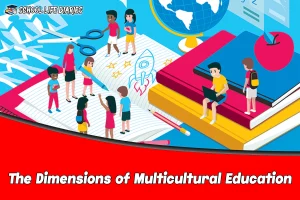Multicultural education is an approach to teaching and learning that values diversity and promotes inclusivity. It recognizes the importance of acknowledging and celebrating different cultures, languages, beliefs, and experiences within our society.
In today’s globalized world, where people from various backgrounds interact with each other on a daily basis, multicultural education has become more relevant than ever before.
The aim of this article is to explore the dimensions and goals of multicultural education. We will examine how it can be integrated into all subject areas, as well as its potential benefits in reducing stereotypes and biases.
What is Multicultural Education?
Multicultural education involves the incorporation of diverse cultural perspectives and experiences into educational practices. This type of education is important because it promotes equity, inclusivity, and social justice in learning environments. Multicultural education recognizes that students come from different backgrounds with varying beliefs, values, and attitudes.
The goal is to create an environment where all students feel valued and understood. One challenge of multicultural education is curriculum integration. Teachers must ensure that they are incorporating a variety of perspectives into their lessons. This can be difficult as some teachers may not have experience with cultures outside their own.
The Dimensions of Multicultural Education
The facets of a diverse student body can be explored through the incorporation of various perspectives and cultural backgrounds into the curriculum. This is where multicultural education comes in, as it aims to promote cultural awareness and sensitivity towards ethnic diversity among students.
It recognizes that each individual comes from a unique background and has different experiences, beliefs, and values that shape their identity. An inclusive curriculum is an important dimension of multicultural education. It involves incorporating content from different cultures into academic subjects such as history, literature, science, and math.
This helps students understand the contributions made by different cultures to society and fosters respect for diverse ways of life. To achieve its goals successfully, multicultural education also requires sensitivity training for teachers. Teachers play a critical role in shaping students’ attitudes towards diversity; therefore, they must possess the necessary skills to create an inclusive classroom environment that promotes acceptance and tolerance towards all individuals regardless of their ethnicity or culture.
By embracing this approach to education fully, schools can create an environment where students feel valued for who they are while building a foundation for future success based on mutual understanding and respect amongst diverse groups of people.
Can Multicultural Education Be Integrated into All Subject Areas, or Is It Limited to Specific Disciplines?
Incorporating diverse perspectives and cultural backgrounds into all subject areas can enhance students’ understanding of the contributions made by different cultures to society, fostering respect for diverse ways of life. This approach to education is known as multicultural education, or an educational strategy that aims to promote diversity and equity in the classroom.
While some may argue that multicultural education is limited to certain disciplines like social studies or language arts, others believe it can be integrated into all subject areas with careful curriculum adaptation. Subject integration involves incorporating diverse perspectives into every aspect of the curriculum.
For example, history lessons could include contributions from historically marginalized groups, while science classes could explore the ways in which different cultures have contributed to scientific discoveries. Engaging students in multicultural education also requires parental involvement.
Parents play a crucial role in helping educators understand their children’s unique cultural backgrounds and providing insight on how best to integrate these backgrounds into the curriculum. By working together, teachers and parents can create a more inclusive learning environment that values diversity and promotes equity for all students.
What Research Supports the Effectiveness of Multicultural Education?
Research has shown that students who receive culturally responsive instruction have higher academic achievement and greater social-emotional well-being than those who do not. Studies have found that multicultural education, when integrated into classrooms, results in increased student engagement and a deeper understanding of diverse perspectives.
This approach encourages students to critically reflect on their own cultural identities while also learning about the experiences of others. Inclusive classrooms are essential for implementing multicultural education. Teachers should create an environment where every student feels valued and respected regardless of their race, ethnicity, or culture.
In addition to creating inclusive environments, teachers need to be trained in strategies that promote multicultural education. Professional development programs can help teachers develop these skills so they can effectively implement culturally responsive instruction in their classrooms.
The long-term impact of multicultural education is significant as it prepares students to become responsible global citizens who are capable of interacting with people from different cultures and backgrounds. Multicultural education promotes empathy, respect for diversity, and critical thinking skills which are important traits for success in today’s interconnected world.
Research findings show that culturally responsive instruction enhances academic performance and prepares students with the skills necessary for future success both academically and socially.
How Can Multicultural Education Help Reduce Stereotypes and Biases?
Culturally responsive instruction is an effective way to reduce stereotypes and biases in the classroom. By challenging assumptions and promoting empathy, multicultural education encourages students to think beyond their preconceived notions of different cultures.
This approach fosters inclusivity by creating a safe space for all students, regardless of their background. Encouraging critical thinking is another important aspect of multicultural education. Students are encouraged to question their own beliefs and assumptions about different cultures, which leads to a deeper understanding and appreciation of diversity.
Through this process, students develop cultural competence, becoming more knowledgeable about other cultures and able to interact respectfully with people from diverse backgrounds. Multicultural education also helps to promote social justice by empowering students to become agents of change in their communities.
By learning about historical injustices and contemporary issues faced by marginalized groups, students become more aware of the systemic inequalities that exist in society. This awareness can inspire them to take action toward creating a more equitable world for all people.
Six Ways Educators Can Implement Multicultural Education in the Classroom
This discussion will focus on six ways that educators can implement multicultural education in the classroom. The first key point is to be aware of biases and work towards eliminating them in order to create a safe and inclusive learning environment.
1. Be Aware of Biases:
Awareness of biases is a crucial aspect to consider in fostering multicultural education. Recognizing biases and overcoming prejudice requires cultural humility and diversity awareness. Educators must be aware of their own unconscious biases, which can manifest in the form of stereotypes or assumptions about certain cultures.
To overcome these biases, educators must engage in intersectionality exploration, which involves recognizing how different aspects of one’s identity intersect with each other and influence one’s perspectives.
2. Value Life Experiences:
Recognizing and valuing the life experiences of students from different backgrounds is paramount to creating an inclusive classroom environment that fosters mutual respect and understanding. Sharing traditions, cultural perspectives, and personal narratives can help students appreciate diversity and develop global awareness.
By exposing students to different cultures, they can broaden their horizons and learn to appreciate differences instead of fearing them. Incorporating multicultural education into the curriculum allows students to gain knowledge about other cultures while also feeling validated in their own experiences.
By providing opportunities for students to share their own cultural backgrounds, teachers can create a safe space where all voices are heard and respected.
3. Understand Student Learning Styles:
By gaining an understanding of student learning styles, educators can create a more effective and engaging classroom environment that caters to the unique needs of each individual learner. There are several approaches to identifying students’ learning styles, such as visual aids, group activities, technology integration, hands-on learning, and differentiated instruction.
Visual learners depend heavily on illustrations and diagrams to process information effectively. Group activities are ideal for students who thrive in social settings while working with others to solve problems.
4. Assign Multicultural Projects:
Assigning projects that explore diverse cultures can broaden students’ perspectives and foster a deeper understanding of the world around them. Multicultural project ideas can range from research assignments to creative expressions, such as music and art.
These projects not only teach students about different cultures but also encourage critical thinking skills and group collaboration. A great way to enhance multicultural education is by incorporating cultural immersion activities into these projects.
For example, asking students to interview people from different cultures in their community or visit local cultural events can provide a deeper level of understanding.
5. Organizing Open Discussions:
One effective approach to promoting cross-cultural understanding in the classroom is through organizing open discussions that allow for the exchange of diverse perspectives. These discussions can take many forms, such as role-playing scenarios, debate competitions, small group discussions, mock trials, and brainstorming sessions.
The goal is to create a safe and inclusive space where students from different cultural backgrounds can share their experiences and viewpoints. During these open discussions, teachers must be mindful of creating an environment that encourages respectful dialogue and active listening.
It is important to establish ground rules beforehand that promote respectful communication and discourage any form of discrimination or prejudice. By facilitating these types of conversations in the classroom, educators provide an opportunity for students to learn from one another’s unique perspectives while also building essential skills like critical thinking, empathy, and effective communication.
6. Promoting Cultural Storytelling:
After organizing open discussions, another effective way of promoting multicultural education is through storytelling techniques. Cultural traditions can be preserved and passed on through intergenerational communication, and in this case, stories serve as a medium for community engagement and diversity appreciation.
Storytelling allows individuals to share their experiences, values, beliefs, and perspectives with others who may have different backgrounds and cultures. Cultural storytelling can take many forms such as oral narratives, written stories, songs, dances, or even artwork. It is not only an effective tool for sharing cultural knowledge but also helps create empathy towards other cultures which could lead to a better understanding of one’s own culture.
By incorporating these techniques within the curriculum or classroom activities teachers can promote cultural sensitivity among students leading to greater acceptance and respect for diversity in the society at large.
Benefits of Implementing Multicultural Education
The implementation of multicultural education can lead to numerous benefits, including increased cultural awareness and understanding among students, improved academic achievement for all students, and the promotion of social justice and equity in schools.
The first benefit is that multicultural education enhances empathy by encouraging students to understand diverse perspectives and experiences. This helps them develop a deeper appreciation for the complexities of human experience, which is an essential skill for living in a globalized world. In addition to enhancing empathy, implementing multicultural education also leads to enhanced critical thinking skills.
By exposing students to diverse viewpoints, they are better able to evaluate information critically and make informed decisions. This skill is particularly important in today’s society where we are constantly bombarded with conflicting information from various sources.
Implementing multicultural education promotes greater tolerance and expands worldview among students. It encourages them to appreciate diversity as a strength rather than a weakness while promoting social justice and equity in schools. Multicultural education creates an environment where everyone feels valued regardless of their race, ethnicity, or socio-economic status.
Students who attend culturally inclusive schools develop an expanded worldview that enables them to interact positively with people from different backgrounds throughout their lives.
Conclusion:
Multicultural education is a vital component of modern education that seeks to promote diversity and equal representation in all subject areas. The dimensions of multicultural education range from content integration, knowledge construction, equity pedagogy, and empowering school culture. Research supports the effectiveness of multicultural education in reducing stereotypes and biases while promoting cultural awareness and understanding among students.
Multicultural education can be integrated into all subject areas through various approaches such as incorporating diverse materials, encouraging critical thinking, creating inclusive classroom environments, and promoting student-centered learning. In essence, implementing multicultural education in the classroom has numerous benefits for both students and educators alike.







